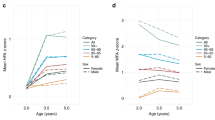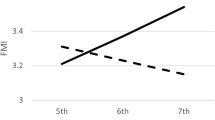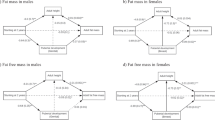Abstract
Background/Objectives
To investigate the associations between indicators of obesity and fat distribution, such as body mass index (BMI), fat mass, and skinfold measures during preschool age, and attained height at school entry.
Subjects/Methods
The Healthy Start primary intervention study comprised 1100 obesity-prone preschool children from the greater Copenhagen area, with a mean [standard deviation (SD)] age of 4.0 (1.1) years at baseline. Anthropometry was measured by trained health professionals at baseline (preschool age) and follow-up height at school entry was gathered by school nurses. Prospective associations between body fat measures and later attained height were examined using generalized linear models with adjustments for potential confounders.
Results
Greater adiposity at preschool age was directly associated with a higher attained height at follow-up at school-age, when adjusting for confounders. A baseline difference of one BMI unit was associated with a greater attained height of 0.8 cm [(95% confidence interval (CI) 0.5; 1.2]. Furthermore, a difference of 1 mm in the sum of four skinfolds measured at baseline was associated with a greater attained height of 0.1 cm (95% CI 0.03; 0.2) at follow-up. Children with overweight or obesity at baseline attained a significantly higher height of 2.9 (95% CI 1.6; 4.1) cm at follow-up after full adjustment than normal weight children.
Conclusions
Our results supports that greater adiposity at preschool age is associated with greater tallness. Although a greater height is assumed to be desirable, accelerated growth in childhood may in itself be a risk factor for obesity later in life.
This is a preview of subscription content, access via your institution
Access options
Subscribe to this journal
Receive 12 print issues and online access
$259.00 per year
only $21.58 per issue
Buy this article
- Purchase on Springer Link
- Instant access to full article PDF
Prices may be subject to local taxes which are calculated during checkout

Similar content being viewed by others
References
Scacchi M, Pincelli AI, Cavagnini F. Growth hormone in obesity. Int J Obes Relat Metab Disord. 1999;23:260–71.
Lettre G. Recent progress in the study of the genetics of height. Hum Genet. 2011;129:465–72.
Marouli E, Graff M, Medina-Gomez C, Lo KS, Wood AR, Kjaer TR, et al. Rare and low-frequency coding variants alter human adult height. Nature. 2017;542:186–90.
Perkins JM, Subramanian SV, Davey Smith G, Ozaltin E. Adult height, nutrition, and population health. Nutr Rev. 2016;74:149–65.
Silventoinen K. Determinants of variation in adult body height. J Biosoc Sci. 2003;35:263–85.
Regnault N, Gillman MW. Importance of characterizing growth trajectories. Ann Nutr Metab. 2014;65:110–3.
Vignolo M, Naselli A, Di Battista E, Mostert M, Aicardi G. Growth and development in simple obesity. Eur J Pedia. 1988;147:242–4.
Freedman DS, Thornton JC, Mei Z, Wang J, Dietz WH, Pierson RN, et al. Height and adiposity among children. Obes Res. 2004;12:846–53.
Stovitz SD, Demerath EW, Hannan PJ, Lytle LA, Himes JH. Growing into obesity: patterns of height growth in those who become normal weight, overweight, or obese as young adults. Am J Hum Biol. 2011;23:635–41.
Silventoinen K, Sammalisto S, Perola M, Boomsma DI, Cornes BK, Davis C, et al. Heritability of adult body height: a comparative study of twin cohorts in eight countries. Twin Res. 2003;6:399–408.
Galobardes B, McCormack V, McCarron P, Howe L, Lynch J, Lawlor D, et al. Social inequalities in height: persisting differences today depend upon height of the parents. PLoS ONE. 2012;7:e29118.
He Q, Karlberg J. Bmi in childhood and its association with height gain, timing of puberty, and final height. Pedia Res. 2001;49:244–51.
De Simone M, Farello G, Palumbo M, Gentile T, Ciuffreda M, Olioso P, et al. Growth charts, growth velocity and bone development in childhood obesity. Int J Obes Relat Metab Disord. 1995;19:851–7.
Kleber M, Schwarz A, Reinehr T. Obesity in children and adolescents: relationship to growth, pubarche, menarche, and voice break. J Pedia Endocrinol Metab. 2011;24:125–30.
Rosario R, Barros R, Padrao P, Santos R, Teixeira VH, Lopes O, et al. Body mass index categories and attained height in Portuguese adults. Obes Facts. 2018;11:287–93.
Peterson CM, Su H, Thomas DM, Heo M, Golnabi AH, Pietrobelli A, et al. Tri-ponderal mass index vs body mass index in estimating body fat during adolescence. JAMA Pedia. 2017;171:629–36.
Olsen NJ, Buch-Andersen T, Handel MN, Ostergaard LM, Pedersen J, Seeger C, et al. The Healthy Start project: a randomized, controlled intervention to prevent overweight among normal weight, preschool children at high risk of future overweight. BMC Public Health. 2012;12:590.
Pan H, Cole T. lmsGrowth, a Microsoft Excel add-in to access growth references based on the LMS method (Version 2.68): www.healthforallchildren.co.uk/. 2009.
Nysom K, Molgaard C, Hutchings B, Michaelsen KF. Body mass index of 0 to 45-y-old Danes: reference values and comparison with published European reference values. Int J Obes Relat Metab Disord. 2001;25:177–84.
Cole T, Bellizi M, Flegal K, Dietz W. Establishing a standard definition for child overweight and obesity worldwide: international survey. Br Med J. 2000;320:1–6.
Goran MI, Driscoll P, Johnson R, Nagy TR, Hunter G. Cross-calibration of body-composition techniques against dual-energy X-ray absorptiometry in young children. Am J Clin Nutr. 1996;63:299–305.
Luo ZC, Albertsson-Wikland K, Karlberg J. Target height as predicted by parental heights in a population-based study. Pedia Res. 1998;44:563–71.
Johnson W, Stovitz SD, Choh AC, Czerwinski SA, Towne B, Demerath EW. Patterns of linear growth and skeletal maturation from birth to 18 years of age in overweight young adults. Int J Obes (Lond). 2012;36:535–41.
Postel-Vinay MC, Saab C, Gourmelen M. Nutritional status and growth hormone-binding protein. Horm Res. 1995;44:177–81.
Shalitin S, Kiess W. Putative effects of obesity on linear growth and puberty. Horm Res Paediatr. 2017;88:101–10.
Novotny R. Trunk:periphery fat ratio. In: Preedy V, editor. Handbook of anthropometry: physical measures of human form in health and disease. London: Springer; 2012. p. 893−900.
Hebert JJ, Moller NC, Andersen LB, Wedderkopp N. Organized sport participation is associated with higher levels of overall health-related physical activity in children (CHAMPS Study-DK). PLoS ONE. 2015;10:e0134621.
Haugaard LK, Baker JL, Perng W, Belfort MB, Rifas-Shiman SL, Switkowski K, et al. Growth in total height and its components and cardiometabolic health in childhood. PLoS ONE. 2016;11:e0163564.
Funding
The Healthy Start Study was supported by grants from the Tryg Fonden (grant: 7984-07, 7106-09, and 7-10-0330), The Danish Medical Research Council (grant: 271-07-0281) and the Helsefonden (grant: 2008B101). The Parker Institute, Bispebjerg and Frederiksberg Hospital is supported by a core grant from the Oak Foundation (OCAY-13-309).
Author information
Authors and Affiliations
Contributions
RR carried out the initial analyses, drafted the initial manuscript, and reviewed and revised the manuscript. NJO is the project coordinator of the “Healthy Start” and critically reviewed the manuscript. She also conceived the study, was responsible for its design and coordination, and helped to draft the manuscript. JFR helped to draft the manuscript. MNH participated in the data collection and helped to draft the manuscript. RS helped to draft the manuscript. JFR, MNH and RS reviewed and revised the manuscript. BLH conceived the study, was responsible for its design and coordination and helped to draft the manuscript. She also conceptualized the study, supervised data collection, reviewed and revised the manuscript. All authors read and approved the final manuscript.
Corresponding author
Ethics declarations
Conflict of interest
The authors declare that they have no conflict of interest.
Additional information
Publisher’s note: Springer Nature remains neutral with regard to jurisdictional claims in published maps and institutional affiliations.
Rights and permissions
About this article
Cite this article
Rosário, R., Olsen, N.J., Rohde, J.F. et al. Longitudinal associations between body composition and regional fat distribution and later attained height at school entry among preschool children predisposed to overweight. Eur J Clin Nutr 74, 465–471 (2020). https://doi.org/10.1038/s41430-019-0494-x
Received:
Revised:
Accepted:
Published:
Issue Date:
DOI: https://doi.org/10.1038/s41430-019-0494-x
This article is cited by
-
To measure growth—pediatrician’s dilemma
European Journal of Clinical Nutrition (2021)



